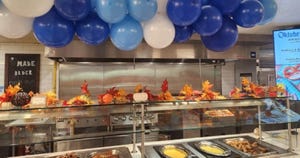Storage Gear: Time for a Change?
June 11, 2008
Shelving and food storage equipment is usually taken for granted—it’s just there when you need it. But manufacturers now design many of these products to not only be efficient but to assist with food safety concerns, too. So now may be a good time to take a look at these back-of-house stalwarts to see if they could use some updating.
Shelving it
When choosing shelving, first check out the environment in which you’ll be using it. Certain shelving materials, like stainless steel, are more suitable for areas of the kitchen that can become wet or damp. Next, determine if the shelving is going to be stationary or moveable. If it may have to be moved, then make sure the unit is adaptable to casters—most, but not all, are. The next question is whether the shelves themselves need to be adjusted frequently. Some shelving systems have quick-release mechanisms for easy adjustments.
Finally, what type of food or equipment will be stored on the shelves? For cookware, utensils and canned goods, wire shelves may be sufficient. But if there’s any chance of food items coming in contact with the shelving, consider shelves or shelf mats coated with an antimicrobial agent. Metro’s MaxQ shelving line has removable polymer shelf mats with Microban antimicrobial protection. The Eagle Group’s LifeStor line also has polymer mats treated with the Microgard antimicrobial.
For storerooms where you really need to max out the available space, track shelving may be a logical choice. Like shifting books on a bookshelf, the shelves slide from side to side on tracks, eliminating the need for aisle space between each shelving unit. The obvious upside with this system is that you can make maximum use of a tight space; the tradeoffs are that the loaded shelves can be heavy to move and it can take more time to find a particular item on a shelf. There are top-mounted systems (like Metro’s Top Track) and floor-mounted systems (Eagle’s FloorTrak) available.
Storing it
In food storage and serving equipment, the trend in materials has been toward polycarbonates and away from metal. Operators who once used metal pans on their food bars and prep tables are now finding polycarbonate an economical alternative. Besides the fact that they’re lighter than metal and won’t rust, an added benefit to polycarbonate pans is that they can help soften the noise level in loud back-of-house situations. Most of the major smallwares manufacturers offer complete lines of polycarbonate food pans in virtually every size you’d need on a food bar. Cambro’s Camwear line, for example, offers removable lids as well as lids that flip open to allow easy access to the pan’s contents.
Polycarbonates have long been favored for food storage containers because of their visibility, lightness and ability to withstand temperature extremes.
When it comes to containers nowadays, it’s hip to be square. Rubbermaid offers a line of square food containers which the company claims can store up to 25 percent more than round containers in the same shelf space. And Carlisle’s square StorPlus food storage boxes are color-coded in standard food safety colors, like yellow, blue and green, to avoid cross-contamination.
You May Also Like




